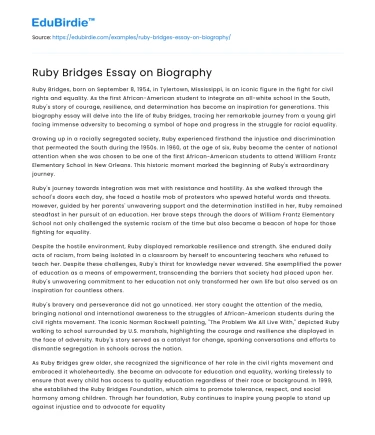Ruby Bridges, born on September 8, 1954, in Tylertown, Mississippi, is an iconic figure in the fight for civil rights and equality. As the first African-American student to integrate an all-white school in the South, Ruby's story of courage, resilience, and determination has become an inspiration for generations. This biography essay will delve into the life of Ruby Bridges, tracing her remarkable journey from a young girl facing immense adversity to becoming a symbol of hope and progress in the struggle for racial equality.
Growing up in a racially segregated society, Ruby experienced firsthand the injustice and discrimination that permeated the South during the 1950s. In 1960, at the age of six, Ruby became the center of national attention when she was chosen to be one of the first African-American students to attend William Frantz Elementary School in New Orleans. This historic moment marked the beginning of Ruby's extraordinary journey.
Ruby's journey towards integration was met with resistance and hostility. As she walked through the school's doors each day, she faced a hostile mob of protestors who spewed hateful words and threats. However, guided by her parents' unwavering support and the determination instilled in her, Ruby remained steadfast in her pursuit of an education. Her brave steps through the doors of William Frantz Elementary School not only challenged the systemic racism of the time but also became a beacon of hope for those fighting for equality.
Despite the hostile environment, Ruby displayed remarkable resilience and strength. She endured daily acts of racism, from being isolated in a classroom by herself to encountering teachers who refused to teach her. Despite these challenges, Ruby's thirst for knowledge never wavered. She exemplified the power of education as a means of empowerment, transcending the barriers that society had placed upon her. Ruby's unwavering commitment to her education not only transformed her own life but also served as an inspiration for countless others.
Ruby's bravery and perseverance did not go unnoticed. Her story caught the attention of the media, bringing national and international awareness to the struggles of African-American students during the civil rights movement. The iconic Norman Rockwell painting, "The Problem We All Live With," depicted Ruby walking to school surrounded by U.S. marshals, highlighting the courage and resilience she displayed in the face of adversity. Ruby's story served as a catalyst for change, sparking conversations and efforts to dismantle segregation in schools across the nation.
As Ruby Bridges grew older, she recognized the significance of her role in the civil rights movement and embraced it wholeheartedly. She became an advocate for education and equality, working tirelessly to ensure that every child has access to quality education regardless of their race or background. In 1999, she established the Ruby Bridges Foundation, which aims to promote tolerance, respect, and social harmony among children. Through her foundation, Ruby continues to inspire young people to stand up against injustice and to advocate for equality and inclusion.
Ruby Bridges' legacy is a testament to the power of one individual to effect change. Her remarkable journey from a young girl facing hostility and racism to becoming an influential advocate and symbol of hope is a testament to her strength and character. Ruby's story reminds us that even in the face of adversity, resilience, determination, and courage can triumph. She serves as an inspiration to all, urging us to continue the fight for equality and justice.
In conclusion, Ruby Bridges' life and accomplishments have left an indelible mark on the history of the civil rights movement. Her courage, resilience, and determination in the face of overwhelming adversity have made her an icon of hope and progress. Ruby's journey as the first African-American student to integrate an all-white school serves as a reminder that one individual can ignite change and inspire others to fight for equality. Ruby Bridges continues to be a beacon of courage and a symbol of hope, reminding us of the importance of standing up for what is right and just in our society.






 Stuck on your essay?
Stuck on your essay?

